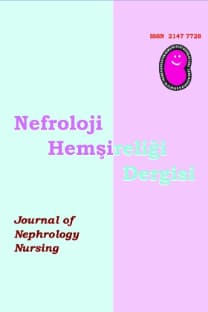Diyaliz Üniteleri Çevre Dostu mu? Bir Anket Çalışması / Are Dialysis Units Environmentally Friendly? A Survey Study
Doğal Kaynakların Korunması, Çevre Dostu, Sürdürülebilirlik, Diyaliz Ünitesi
Are Dialysis Units Environmentally Friendly? A Survey Study
___
- 1. Buturović-Ponikvar J. Humanization of Dialysis: Green And Cozy: 2ND International Academic Conference Places and Technologies 2015.
- 2. Süleymanlar G, Ateş K, Seyahi N. Türkiye 2019 Yılı Ulusal Nefroloji, Diyaliz ve Transplantasyon Kayıt Sistemi Raporu. Ankara: Türk Nefroloji Derneği Yayınları. 2020:51-60.
- 3. Piccoli GB, Nazha M, Ferraresi M, Vigotti FN, Pereno A, Barbero S. Eco-dialysis: the financial and ecological costs of dialysis waste products: is a ‘cradle-to-cradle’model feasible for planet-friendly haemodialysis waste management? Nephrology Dialysis Transplantation. 2015;30(6):1018-27. https://doi.org/10.1093/ndt/gfv031
- 4. Bendine G, Autin F, Fabre B, Bardin O, Rabasco F, Cabanel J-M, et al. Haemodialysis therapy and sustainable growth: a corporate experience in France. Nephrology Dialysis Transplantation. 2020;35(12):2154-60. https://doi.org/10.1093/ndt/gfz284
- 5. Blankestijn PJ. Towards sustainable environmental development in nephrology care, research and education. Nature Reviews Nephrology. 2020:1-2. https://doi.org/10.1038/s41581-020-00353-8
- 6. Connor A, Milne S, Owen A, Boyle G, Mortimer F, Stevens P. Toward greener dialysis: a case study to illustrate and encourage the salvage of reject water. Journal of renal care. 2010;36(2):68-72. https://doi.org/10.1111/j.1755-6686.2010.00153.x
- 7. Green Dialysis. Why go green? 2020 [Available from: https://www.greendialysis.org/about/why-green Erişim Tarihi: 01.02.2021
- 8. U.S. Environmental Protection Agency. Office of air and radiation, climate protection partnerships division. 2010. What is a green building? Fundamental principles of green building and sustainable site design, 2010 [Available from: http://www.epa.gov/statelocalclimate/documents/pdf/12_8_what_is_green_GGGC.pdf,. Erişim Tarihi: 05.03.2021
- 9. Özdemir M. Yeşil Hastane Tasarım Ölçütlerinin İrdelenmesi ve Tasarıma İlişkin Çözüm Önerileri. İstanbul: Yıldız Teknik Üniversitesi 2017.
- 10. Albrecht S, Petrin B. Establishing a sustainable vision for healthcare. An Interactive Qualifying Project Report, Worcester Polytechnic Institute. 2010.
- 11. Barraclough KA, Agar JW. Green nephrology. Nature Reviews Nephrology. 2020;16(5):257-68. https://doi.org/10.1038/s41581- 019-0245-1
- 12. Karaca PÖ, Atilgan E, Zekioğlu A. Sağlik Hizmetlerinde Sürdürülebilirlik Bağlaminda İnovatif Bir Uygulama: Yeşil Hastaneler. Ejovoc (Electronic Journal of Vocational Colleges). 2018;8(2):77-87.
- 13. Palteki AS, İnce GN. İstanbul’daki kamu hastanelerinin yeşil hastane ölçütlerine uygunluklarının belirlenmesi Mayıs 22-23: II. Ulusal Sağlık Kuruluşları Çevre Yönetimi Sempozyumu; 2014 [
- 14. Onaran S. Sürdürülebilir yeşil hastane süreçlerinde güncel kalite anlayışları. : İstanbul Medipol Üniversitesi.; 2019.
- 15. Hayran O. Sağlık politikalarının geleceği ve sürdürülebilirlik 2016 [Available from: https://www.sdplatform.com/Yazilar/KoseYazilari/473/Saglik-politikalarinin-gelecegi-ve-surdurulebilirlik.aspx.Erişim Tarihi: 05.03.2021
- 16. Terekli G, Özkan O, BAYIN G. Çevre dostu hastaneler: Hastaneden yeşil hastaneye. Ankara Sağlık Hizmetleri Dergisi. 2013;12(2):37-54.
- 17. Centre for Sustainable Healthcare. Kidney Care 2013 [Available from: https://sustainablehealthcare.org.uk/what- wedo/sustainable- specialties/kidney- care. Erişim Tarihi: 01.02.2021
- 18. Green Dialysis. Introduction to Sustainable Dialysis, 2020 [Available from: https://www.greendialysis.org/about/introductionto-sustainable-dialysis Erişim Tarihi: 01.02.2021
- 19. Azar FE, Farzianpour F, Foroushani AR, Badpa M, Azmal M. Evaluation of green hospital dimensions in teaching and private hospitals covered by Tehran University of Medical Sciences. Journal of Service Science and Management. 2015;8(02):259. DOI:10.4236/jssm.2015.82029
- 20. Barraclough KA, Gleeson A, Holt SG, Agar JW. Green dialysis survey: Establishing a baseline for environmental sustainability across dialysis facilities in Victoria, Australia. Nephrology. 2019;24(1):88-93. https://doi.org/10.1111/nep.13191
- 21. Çilhoroz Y, Oğuz I. Ankara’daki Hastanelerin Yeşil Hastane Ölçütlerine Uygunluğunun İncelenmesi. Hacettepe Sağlık İdaresi Dergisi. 2018;21(1):65-85.
- 22. Palteki AS. İstanbul’daki Kamu Hastanelerinin Yeşil Hastane Ölçütlerine Uygunluklarının Belirlenmesi. İstanbul: İstanbul Üniversitesi 2013.
- 23. Moura-Neto JA, Barraclough K, Agar JW. A call-to-action for sustainability in dialysis in Brazil. Brazilian Journal of Nephrology. 2019;41(4):560-3. https://doi.org/10.1590/2175-8239-jbn-2019-0014
- 24. Piccoli GB, Cupisti A, Aucella F, Regolisti G, Lomonte C, Ferraresi M, et al. Green nephrology and eco-dialysis: a position statement by the Italian Society of Nephrology. Journal of nephrology. 2020;33(4):681-98. https://doi.org/10.1007/s40620-020- 00734-z
- 25. Molano-Triviño A, Wancjer B, Neri MM, Karopadi AN, Rosner M, Ronco C. Blue Planet dialysis: novel water-sparing strategies for reducing dialysate flow. The International journal of artificial organs. 2018;41(1):3-10. https://doi.org/ 10.5301/ijao.5000660
- 26. Agar JW. Reusing and recycling dialysis reverse osmosis system reject water. Kidney international. 2015;88(4):653-7. https://doi.org/10.1038/ki.2015.213
- 27. Ponson L, Arkouche W, Laville M. Toward green dialysis: focus on water savings. Hemodialysis International. 2014;18(1):7-14. https://doi.org/10.1111/hdi.12117
- 28. Mesic E, Bock A, Major L, Vaslaki L, Berta K, Wikstrom B, et al. Dialysate saving by automated control of flow rates: comparison between individualized online hemodiafiltration and standard hemodialysis. Hemodialysis International. 2011;15(4):522-9. https://doi.org/10.1111/j.1542-4758.2011.00577.x
- 29. Agar JW, Perkins A, Tjipto A. Solar-assisted hemodialysis. Clinical Journal of the American Society of Nephrology. 2012;7(2):310-4. https://doi.org/10.2215/CJN.09810911
- 30. Intergovernmental Panel on Biodiversity and Ecosystem Services. Media release: nature’s dangerous decline ‘unprecedented’; species extinction rates ‘accelerating 2019 [Available from: https://www.ipbes.net/news/Media- Release-Global- Assessment Erişim Tarihi: 02.02.2021
- Yayın Aralığı: Yılda 3 Sayı
- Başlangıç: 2004
- Yayıncı: Türk Nefroloji, Diyaliz ve Transplantasyon Hemşireleri Derneği
Zülfünaz ÖZER, Gülcan BAHÇECİOĞLU TURAN, Tülay AKSOY
Filiz ALTINDAL, Hasan KAYABAŞI, Dede ŞİT, Ezgi ERSOY YEŞİL, Funda YILMAZ, Yağmur KIZILAY, Ayten KARAKOÇ
